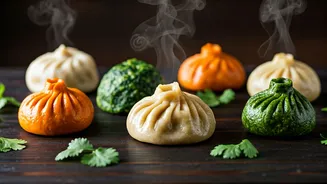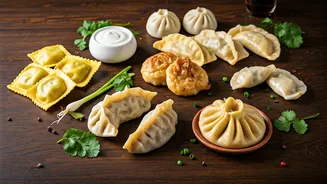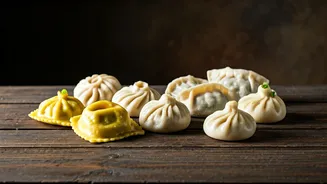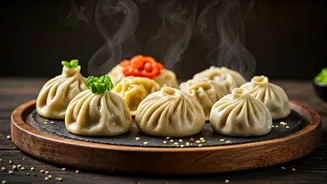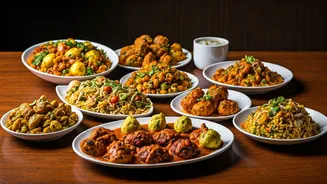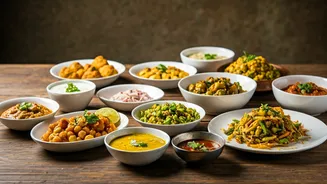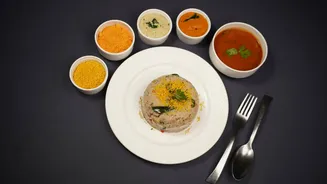Steamed Baozi: Fluffy Clouds
Baozi, or bao, are fluffy, steamed buns typically filled with savory ingredients. Originating from China, these delightful pockets of goodness are a popular
street food and breakfast staple. The soft, pillowy exterior contrasts beautifully with the flavorful filling, which can range from pork and vegetables to sweet bean paste. The preparation involves a meticulous process of making the dough, allowing it to rise, and carefully wrapping the filling before steaming. The result is a satisfying and portable meal, perfect for a quick bite or a more leisurely feast. The fluffy texture of the bun provides a wonderful contrast to the savory, often juicy, filling, making each bite a delightful experience. They're found in various sizes and shapes, and are a true example of culinary versatility.
Xiao Long Bao: Soup Inside!
Xiao Long Bao, also known as soup dumplings, are a Shanghai specialty that are celebrated worldwide. The magic lies within the delicate, thin-skinned dumplings, which contain a rich and flavorful broth alongside the meat filling, typically pork. The preparation requires a clever technique: the soup is usually solidified into a jelly, which is then incorporated into the filling mixture. As the dumplings steam, the jelly melts, creating a burst of hot, savory broth. These dumplings are typically served in a bamboo steamer, and diners enjoy them by carefully biting a small piece to sip the soup before consuming the rest. The experience is a multi-sensory delight: the visual appeal, the aroma, the delicate texture, and the explosion of flavor.
Pierogi: Polish Perfection
Originating from Poland, pierogi are semi-circular dumplings filled with a variety of ingredients, from potatoes and cheese to sauerkraut and meat. They are typically boiled or pan-fried, then often served with toppings like sour cream, fried onions, or bacon. The dough for pierogi is usually made with flour, water, and sometimes eggs and sour cream, giving it a slightly chewy texture. The fillings are often seasoned with herbs and spices to enhance their flavor. Pierogi are a staple in Polish cuisine and are a symbol of comfort food, enjoyed during both everyday meals and special occasions. The preparation, which is a labor of love, showcases the culture's dedication to home-style cooking and tradition.
Gyoza: Japanese Delight
Gyoza, the Japanese version of Chinese potstickers, are pan-fried dumplings filled with ground meat, vegetables, and seasonings. The dumplings are first pan-fried to create a crispy bottom, then steamed to cook the filling and the top portion of the wrapper. They are often served with a dipping sauce, which typically includes soy sauce, vinegar, and chili oil. The preparation of gyoza includes a balance of textures, including the crispness of the bottom and the tenderness of the filling. Gyoza are a popular appetizer and are often enjoyed with a cold beer or sake. They are a testament to how culinary traditions can evolve and adapt across borders. The aroma of gyoza cooking is often a signal of a delicious meal about to be enjoyed.
Momos: Himalayan Treasure
Momos, originating from Tibet and Nepal, are steamed or fried dumplings filled with meat or vegetables, seasoned with Himalayan spices. Served with a spicy chutney or dipping sauce, momos are a popular street food and a staple in the Himalayan regions. The dough is typically made from wheat flour and water, and the fillings are a mixture of minced meat or finely chopped vegetables, combined with aromatic spices. The preparation involves carefully folding the dough around the filling to create a crescent or round shape. The simplicity of the ingredients combined with the aromatic spices creates a memorable flavor profile. The popularity of momos reflects the cultural exchange and fusion of flavors that are common in this region.
Mandu: Korean Comfort
Mandu, the Korean version of dumplings, come in a variety of shapes, sizes, and fillings. They can be steamed, boiled, pan-fried, or deep-fried. The fillings typically include ground meat, tofu, vegetables, and glass noodles, seasoned with soy sauce, sesame oil, and other spices. Mandu are a versatile dish, enjoyed as a snack, a side dish, or a main course. The preparation is a family affair, with many households making their own mandu, especially during special occasions like Korean New Year. The cooking method also varies, as some prefer boiled mandu, while others go for the crispy texture of the fried or pan-fried versions. Each bite offers a satisfying experience that demonstrates the variety and the comfort of Korean culinary traditions.
